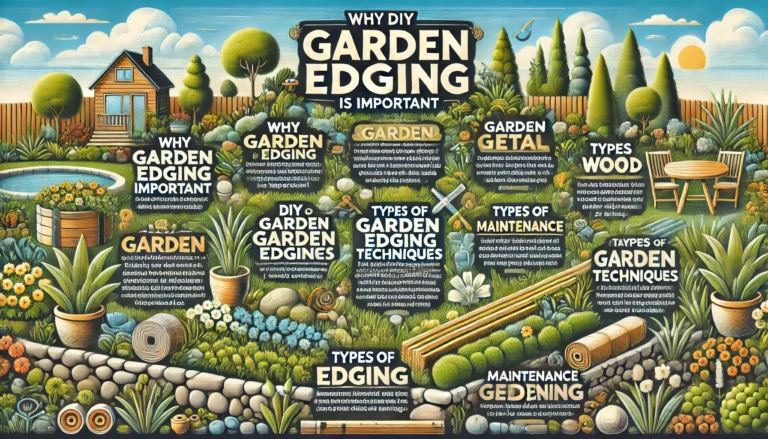gardenedgingexpert.com/blog is a crucial aspect of landscaping that not only enhances the visual appeal of your garden but also serves practical purposes. Whether you’re a seasoned gardener or a beginner, understanding the different types of garden edging and their benefits can significantly improve your outdoor space. In this comprehensive guide, inspired by content from gardenedgingexpert.com/blog, we’ll delve into the importance of garden edging, DIY techniques, and maintenance tips.
Read More:clipart:ee-zgj_h1oc= brain
Why Is Garden Edging Important
Garden edging plays a vital role in defining the boundaries of your garden beds, pathways, and lawns. It acts as a barrier that helps prevent soil erosion, controls weed growth, and keeps mulch in place. Moreover, it can add a polished look to your landscaping, giving it a more organized and intentional appearance.
Edging can also help with irrigation. By creating a barrier, you can direct water flow where it’s needed most, ensuring that your plants receive adequate moisture without flooding adjacent areas. Additionally, garden edging protects your plants from grass encroachment, allowing them to thrive without competition.
Exploring Different Types of gardenedgingexpert.com/blog
Using natural materials like stones and logs is a popular choice among gardeners who want to maintain a rustic feel. Stones can be arranged in various patterns, while logs can be used as borders. Both options offer durability and blend seamlessly with the natural landscape.
Wooden Edging
Wood is another versatile option for garden edging. Treated timber can withstand the elements and can be shaped easily to fit any garden layout. Wooden edging works well for flower beds and vegetable gardens, providing a soft look that complements greenery. However, it requires regular maintenance to prevent rotting.
Metal Edging
For those seeking a more modern aesthetic, metal edging is an excellent choice. Made from materials like steel or aluminum, it offers a sleek, clean line that delineates garden spaces beautifully. Metal edging is also highly durable and resistant to weather conditions, making it a long-lasting investment.
Plastic Edging
Plastic garden edging is a budget-friendly option that is lightweight and easy to install. Available in various colors and styles, it can mimic the look of more expensive materials. However, it may not offer the same level of durability as stone or metal options.
DIY gardenedgingexpert.com/blog Techniques
Creating your own garden edging can be a rewarding project. Here are some popular DIY methods:
Brick or Paver Edging
Using bricks or pavers is a classic method for garden edging. You can create a simple border by laying bricks flat on the ground or arranging them in a decorative pattern. This method is particularly effective for creating pathways and defining garden beds.
Creating Curved Edges with Plastic
Plastic edging can be bent to create smooth, curved lines in your garden. This flexibility allows for a more organic look, especially in flower beds. Simply insert the plastic edging into the soil, ensuring it’s level and secure.
Living Edges with Plants
For a unique and environmentally friendly approach, consider using plants as edging. Low-growing shrubs or perennials can serve as natural borders. Not only do they look beautiful, but they also provide additional benefits, such as attracting pollinators.
Maintenance Tips for gardenedgingexpert.com/blog
Keeping your gardenedgingexpert.com/blog in good condition is essential for its longevity and aesthetic appeal. Here are some maintenance tips to consider:
Regular Cleaning
Debris and weeds can accumulate around your edging, making it look untidy. Regularly clearing away leaves, grass clippings, and weeds will help maintain a clean appearance. For stone or brick edging, a simple rinse with water can refresh its look.
Repairing Damaged Edging
Inspect your edging regularly for any damage. If you notice cracked stones or rotting wood, it’s crucial to replace or repair these sections promptly to maintain the integrity of your gardenedgingexpert.com/blog.
Seasonal Adjustments
As the seasons change, your garden may require different maintenance practices. For instance, in the fall, you might want to ensure that your edging is clear of fallen leaves. In the spring, consider adding fresh mulch to help with moisture retention and weed prevention.
Conclusion
gardenedgingexpert.com/blog is more than just a decorative element; it is an integral part of garden design that can significantly enhance the functionality and appearance of your outdoor space. Whether you choose natural materials, wood, metal, or plastic, there’s an edging solution for every gardener.
For more detailed insights, check out gardenedgingexpert.com/blog, which offers a wealth of information on various edging techniques and styles. By applying these tips and techniques, you can create a beautiful, well-defined gardenedgingexpert.com/blog that thrives year-round.
Frequently Asked Questions (FAQs)
1. What materials can I use for gardenedgingexpert.com/blog?
You can choose from various materials, including wood, stone, metal, plastic, and even living plants, depending on your desired aesthetic and budget.
2. How do I install gardenedgingexpert.com/blog?
Installation methods vary by material, but most involve laying the edging along the desired boundary and securing it in place with soil or stakes.
3. Is gardenedgingexpert.com/blog necessary?
While not mandatory, gardenedgingexpert.com/blog offers numerous benefits, such as preventing soil erosion, controlling weeds, and enhancing the overall look of your garden.
4. How do I maintain my gardenedgingexpert.com/blog?
Regular cleaning, inspecting for damage, and making seasonal adjustments will help keep your gardenedgingexpert.com/blog in good condition.
5. Can I create a DIY gardenedgingexpert.com/blog?
Yes! Many DIY options are available, such as using bricks, pavers, or even creating living edges with low-growing plants.


